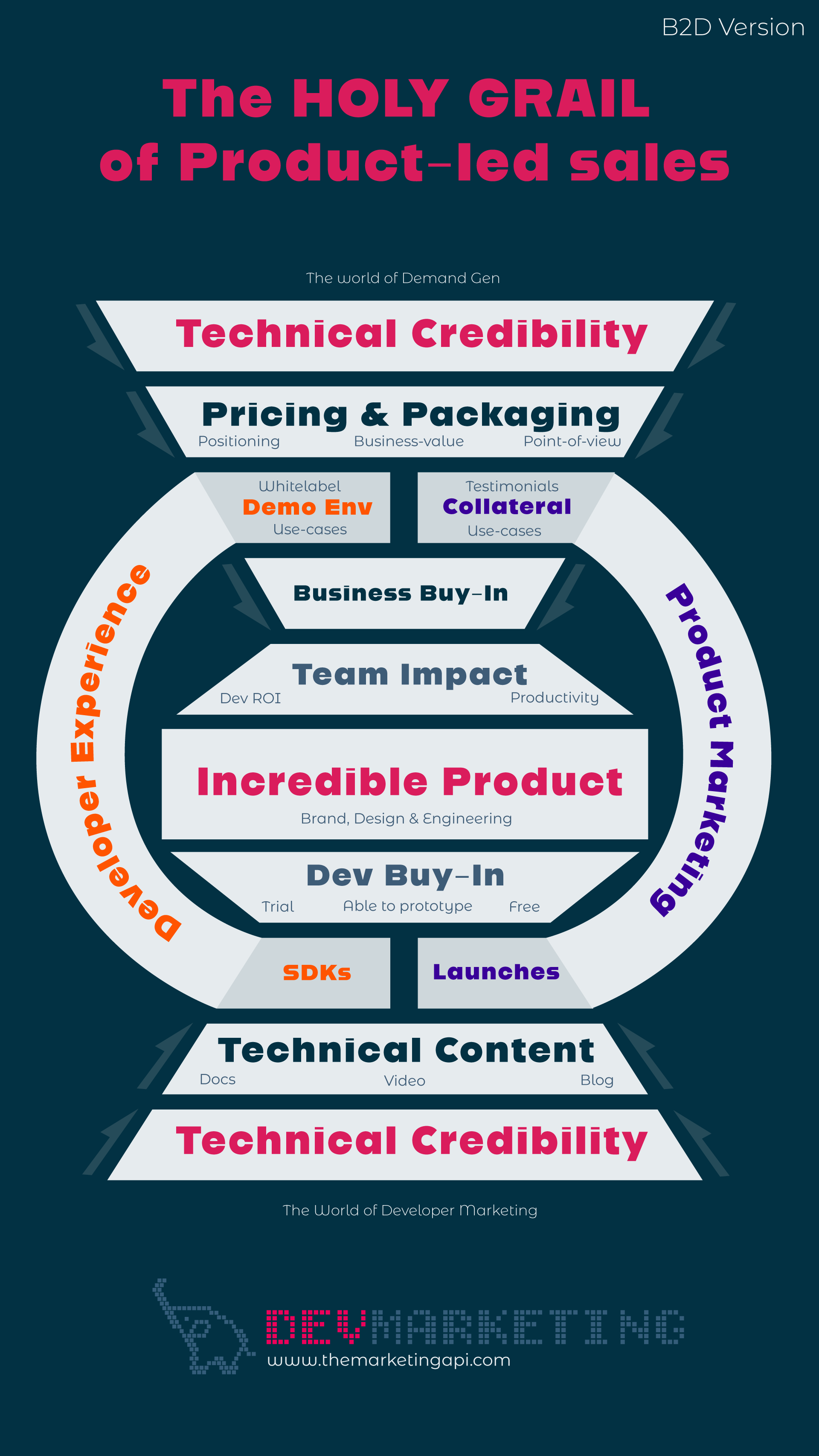Demystifying Product-Led Sales: The Holy Grail for B2D Companies

In my interactions with technical founders, the concept of Product-Led Sales (PLS) often sparks curiosity and requires clarification. It’s a relatively new term, sometimes misinterpreted, that blends elements of product-led growth with a unique sales dynamic.
Think of PLS as a two-pronged approach: bottom-up adoption by individual developers coupled with a top-down sales strategy targeting the organization. The product itself serves as the initial touchpoint, captivating developers and showcasing its value. However, the ultimate goal is to secure a company-wide agreement, not just individual subscriptions.
To illustrate this effectively, I created the visual aid above.
Let’s break down the core components:
1. The Core: An Incredible Product
The bedrock of any successful PLS strategy for a developer (B2D) company is, unsurprisingly, an exceptional product. This encompasses aspects like intuitive design, robust engineering, and a strong brand identity. Developers should be able to effortlessly try, prototype, and experience the product’s value firsthand, often through freemium models or accessible trials. I often advise companies to think of this as the first magical moment for a developer.
In the early days of Twilio this magic was obvious. The product could literally send texts and make phone calls, with just a little code— but for many new dev tools, you need to make sure you show how your product is magical. Don’t just rely on us developers to intuit the magic, but define it on your terms.
2. Developer Buy-in: The Bottom-Up Approach
Technical content plays a pivotal role in attracting and engaging developers. Comprehensive documentation, insightful blog posts, engaging videos, and well-maintained SDKs foster trust and understanding. This developer-centric approach establishes technical credibility and drives organic adoption within organizations.
By focusing on highly credible content you are signaling to developers that you care about their experience and you prioritize education. Conversely, using chat gpt to create highly fluffy and “salesy” content about the value of your product, will only convice devs that you are not interested in their opinion. Start with technical content and your brand will have room to grow.
3. Business Buy-in: The Top-Down Strategy
While developers champion the product, securing buy-in from decision-makers requires a different approach. This is where pricing and packaging strategies come into play, focusing on demonstrable ROI, quantifiable productivity gains, and a clear understanding of the product’s impact on team performance. White-labeled demo environments, compelling testimonials, and tailored use cases further reinforce the value proposition for the organization.
While some of this is advanced baseball and is not really tailored to an early-stage company (like the ones I am working with) the foundation of this strategy can be laid by your founding team. Start trying to quantify the business impact inside some of your first customers, and reflect this back to them. Often dogfooding your own product can help you discover some of these messages.
4. The Synergy: Product Marketing & Developer Experience
Product marketing acts as the bridge between the two approaches. By effectively positioning the product and highlighting its business value, marketing efforts align with both developer needs and organizational objectives. This creates a cohesive narrative that resonates throughout the buying process.
A good product marketer or developer advocate is worth their weight in gold. This has become one of my favorite hats to wear as it serves so many teams out of the gate. Lastly, early-stage companies should think about product-launches as milestone events to build momentum (both fund-raising and internal buy-in) around.
5. The Holy Grail: Technical Credibility
The culmination of these efforts is achieving technical credibility. This is the sweet spot where developers advocate for the product while decision-makers recognize its strategic value, ultimately leading to successful sales closures.
The reality is that both parties are sniffing out your approach trying to gauge if your product has some technical heft. There are too many solutions out right now that are thinly veiled wrappers for already existing tools, and if you are an open-source tool that is adding a cloud-hosted layer, you need to think extra hard about this. There needs to be a significant technical reason to use your product, ideally one that some engineers (thought leaders and trend-setters) are beginning to think about. Your voice should be one of the more technical voices in the debate, with a clear point-of-view on the subject.
In Conclusion:
Product-Led Sales is a nuanced approach that requires a deep understanding of developer behavior and organizational buying processes. By focusing on a stellar product, fostering developer buy-in through technical content, and strategically demonstrating business value, companies can unlock the full potential of this powerful sales model.
If you are building a PLS motion from scratch, or just want to discuss where I am full of hot air, please book some time with me or shoot me an email at jarod@themarketingapi.com.